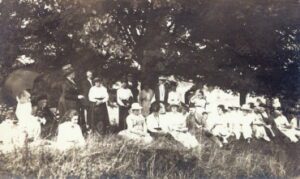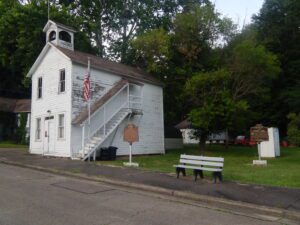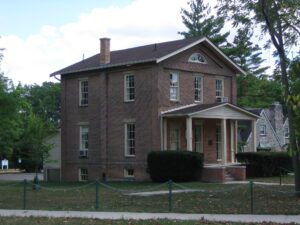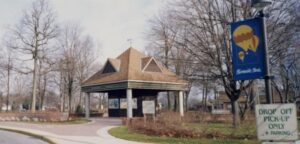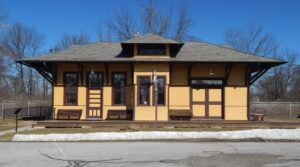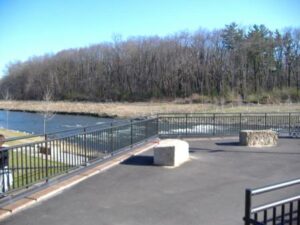, OH
As he traveled the National Road on August 20, 1835, the last diary entry by Christopher C. Baldwin, librarian for the American Antiquarian Society in Worcester, Massachusetts, was, “Start by stage on the Cumberland Road for Zanesville.” Baldwin never reached Zanesville or his ultimate destination, which was to investigate prehistoric mounds in southern Ohio on behalf of the Antiquarian Society. On that day, near this site, he was killed in what is considered to be the first traffic fatality recorded in Ohio. While passing a drove of hogs on the road, the horses pulling the stage became unmanageable and when the driver tried to check their speed on a decline, the stage turned over. Baldwin was riding with the driver and was killed when the stage rolled over on him. Due to the lateness of the season and the distance from his home, his remains were interred in Norwich.
, OH
After embracing the cause of women’s suffrage, Harriet Taylor Upton (1854-1945) devoted her life to the movement. Born in Ravenna, she moved to Warren as a child and lived in this house beginning in 1873. Upton was treasurer of the National American Woman Suffrage Association from 1895 to 1910 and brought its headquarters to Warren in 1903, where it remained until 1910. She served as president of the Ohio Woman Suffrage Association for 18 years. As the first woman vice chair of the National Republican Executive Committee, Upton was instrumental in the passage of child labor laws and securing governmental appointments for women. Her devotion to women’s causes and skills as a public speaker earned her nationwide respect.
, OH
“I say white brother, because I believe that to be the proper phrase, inasmuch as I believe in the principle of the fatherhood of God and the brotherhood of all mankind no matter what the color of his skin may be.” Richard L. Davis championed the cause of racial equality throughout the eastern coalfields, calling for an end to the color line and for all miners to unite against wage slavery. He was born in Roanoke County, Virginia in 1862 and arrived in racially integrated Rendville in 1882, where he became an organizer for the Knights of Labor. In 1886, a year after the Great Hocking Valley Strike, Davis wrote his first letters to the editor of the National Labor Tribune, establishing himself as voice for miners in the labor movement. (Continued on other side)
, OH
Reverend Lorenzo Langstroth, renowned as “The Father of American Beekeeping,” lived in this simple two-story, eight-room house with his wife, Anne, and their three children from 1858 to 1887. Unchanged externally, the Greek Revival cottage features brick pilasters and pediments and a fan-shaped front window. In his garden workshop, Langstroth made experimental beehives, established an apiary, and on the ten acres that surrounded his home, grew buckwheat, clover, an apple orchard, and a “honey garden” of flowers. He imported Italian queen bees in efforts to improve native bees and shipped his queens to keepers across the United States and around the world. The Langstroth Cottage was placed on the National Register of Historic Places in 1976 and designated a National Historic Landmark in 1982. (Continued from other side)
, OH
One of the earliest and largest amusement parks in Northwest Ohio dedicated in 1906 on site of old waterworks. Trains brought visitors from as far away as Cleveland. 1907: Dance Pavilion and 2,000 seat auditorium built. 1908: Bathing beach made in old reservoir. 1925: Green Mill Dance Hall built on side near dam. Big name bands highlight entertainment. 1936: Shelters, band shell, and pool bath house made from bricks of old waterworks. 1978: Renovation of waterfront begins new era.
, OH
Arriving in 1853, the Central Ohio Railroad called this place “Kirkersville Station,” and it was later changed by stationmaster James Outcalt, who renamed the town Outville after himself. As rail traffic increased in Ohio, a successor company, the Baltimore and Ohio Railroad, built numerous rural depots, this one in 1899. After 1940, the depot was closed and then sold and moved from town in 1963. The Harrison Township Trustees arranged for the return of the depot to Outville in 1993. Today, it stands as the only one of its type remaining on this line, and one of only a handful of original railroad buildings extant between Columbus and Pittsburgh. It serves as a reminder of local railroad and transportation history. The Queen Anne, Stick/Eastlake architectural style depot was listed on the National Register of Historic Places in 1995.
, OH
Considered a bold experiment in community planning, Greenhills was intended to relieve an acute housing shortage and to provide jobs during the Great Depression. In 1935, the administration of President Franklin Roosevelt authorized the construction of three greenbelt communities: Greendale, Wisconsin; Greenbelt, Maryland; and Greenhills, Ohio. The construction of Greenhills began on December 16, 1935. The project generated thousands of jobs and, ultimately, 676 units of housing for working people. On April 1, 1938, the first Greenhills “Pioneers” moved into homes on Avenell Lane. Greenhills reflects the town planning principles of the English “garden city” movement. Planners clustered homes around a common green space and a community shopping area was within easy walking distance. Like the original greenbelt of forests and farms, today Winton Woods Park serves as a buffer for the Village. The original federally built center of Greenhills was added to the National Register of Historic Places in 1989.
, OH
Officially opening on August 4, 1840, the Pennsylvania and Ohio Canal followed the route of present railroad tracks through Munroe Falls approximately one thousand feet south of this marker. This 82-mile long "feeder canal" connected the Beaver Valley canal system at New Castle, Pennsylvania with the Ohio and Erie Canal in Akron, thereby linking Pittsburgh with Cleveland and the western Great Lakes. Many communities along the canal’s path became linked to national and world commerce through their establishment as canal ports. New England investor Edmund Munroe purchased property and water rights along the canal’s proposed route, and in 1837 established the Munroe Falls Manufacturing Company. The village of Munroe Falls grew around the manufacturing company site and was incorporated on October 26, 1838. When this section of the canal closed in 1869, the waterway through Munroe Falls was filled and railroad tracks were laid over its path. A portion of the canal bed is still visible east of State Route 91.



